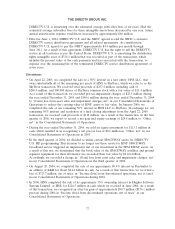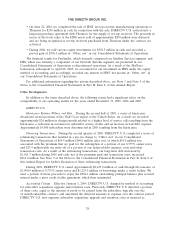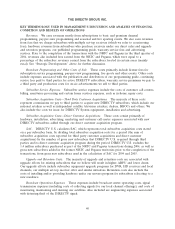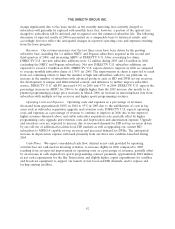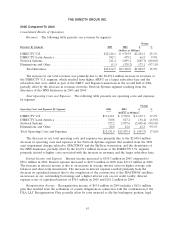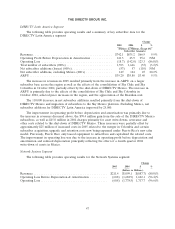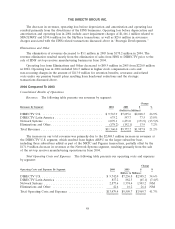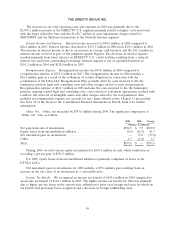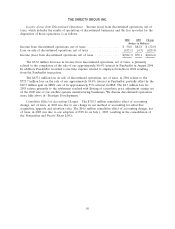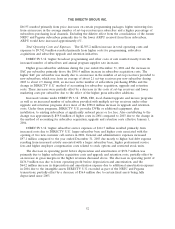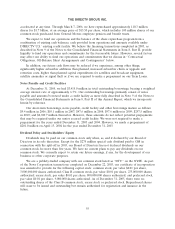DIRECTV 2005 Annual Report Download - page 59
Download and view the complete annual report
Please find page 59 of the 2005 DIRECTV annual report below. You can navigate through the pages in the report by either clicking on the pages listed below, or by using the keyword search tool below to find specific information within the annual report.THE DIRECTV GROUP, INC.
and a more competitive marketplace. After accounting for this churn, DIRECTV U.S. added 1,193,000
net new subscribers in 2005 compared to 1,728,000 in 2004.
Revenues. DIRECTV U.S.’ revenues increased $2,452.2 million to $12,216.1 million resulting from
higher ARPU on the larger subscriber base and the full year effect of the Pegasus and NRTC
subscribers that DIRECTV U.S. purchased in the second half of 2004. The 4.0% increase in ARPU to
$69.61 resulted primarily from price increases on certain programming packages and higher mirroring
fees from an increase in the average number of set-top receivers per subscriber. Excluding the dilutive
effect from the consolidation of the former NRTC and Pegasus subscribers, primarily due to the lower
ARPU received from these subscribers, ARPU would have increased approximately 6%.
Total Operating Costs and Expenses. DIRECTV U.S.’ total operating costs and expenses increased
$1,672.1 million to $11,414.1 million resulting primarily from higher costs for programming, subscriber
service expenses, general and administrative expenses, depreciation and amortization expense, and
subscriber upgrade and retention initiatives. Operating costs and expenses as a percentage of revenues
decreased from approximately 100% in 2004 to 93% in 2005 mostly due to the stabilization of costs in
key areas such as subscriber acquisition, upgrade and retention.
DIRECTV U.S.’ broadcast programming and other costs of sale increased $1,039.6 million
primarily as a result of the increased number of subscribers and annual program supplier rate increases.
Subscriber service expenses increased as a result of the larger subscriber base.
Subscriber acquisition costs were stable in 2005 compared to 2004. However, SAC per subscriber
was slightly lower due to a decrease in the cost of set-top receivers, mostly offset by an increase in the
number of set-top receivers provided to new subscribers, including a greater number of higher cost HD
and DVR products.
Increased volume under DIRECTV U.S.’ movers and HD upgrade programs drove most of the
$113.3 million increase in upgrade and retention costs. Under these programs, DIRECTV U.S. provides
additional equipment, plus installation, to existing subscribers at significantly reduced prices.
The $140.0 million increase in general and administrative expenses resulted primarily from higher
bad debt expense resulting from the increase in the subscriber base and involuntary churn discussed
above, and an increase in other expenses, such as labor, benefits and consulting, to support the larger
business.
The improvement of operating profit before depreciation and amortization of $917.1 million was
primarily due to higher margins from the increase in revenues combined with the stabilizing of costs in
key areas such as subscriber acquisition, upgrade and retention. The improvement in operating profit of
$780.1 million was primarily due to higher operating profit before depreciation and amortization and
lower depreciation expense resulting from assets becoming fully depreciated in 2005, more than offset
by higher amortization of about $181 million resulting from intangible assets recorded as part of the
NRTC and Pegasus transactions.
46



